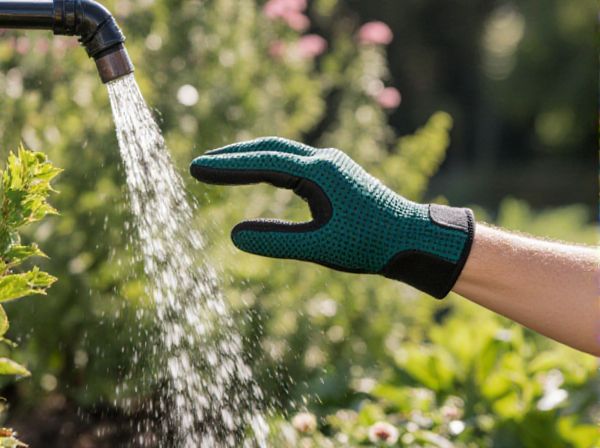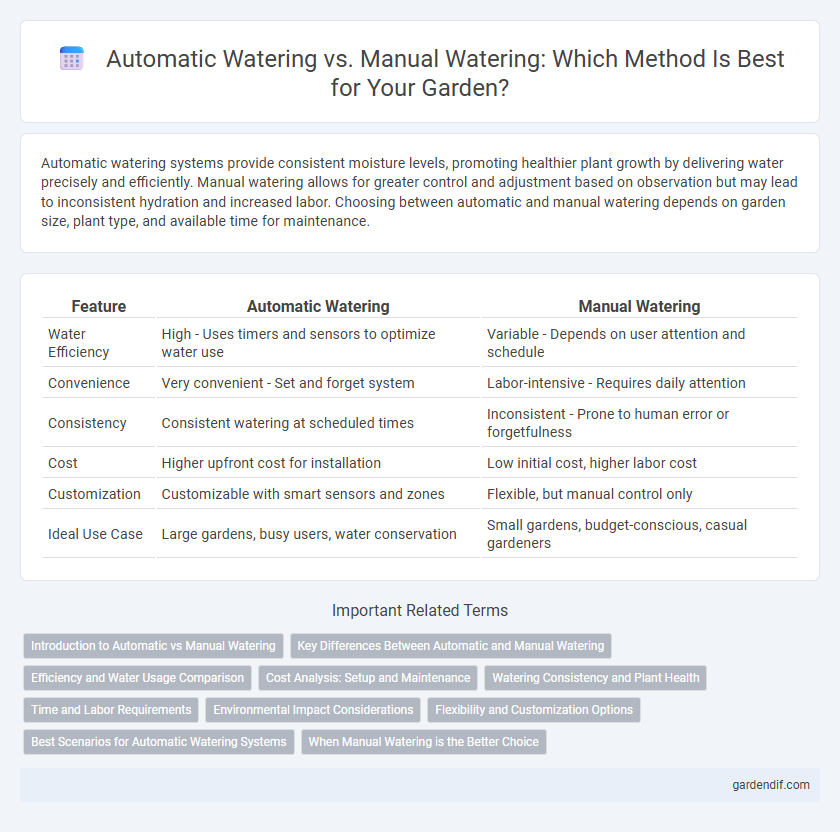
Automatic watering vs Manual watering Illustration
Automatic watering systems provide consistent moisture levels, promoting healthier plant growth by delivering water precisely and efficiently. Manual watering allows for greater control and adjustment based on observation but may lead to inconsistent hydration and increased labor. Choosing between automatic and manual watering depends on garden size, plant type, and available time for maintenance.
Table of Comparison
| Feature | Automatic Watering | Manual Watering |
|---|---|---|
| Water Efficiency | High - Uses timers and sensors to optimize water use | Variable - Depends on user attention and schedule |
| Convenience | Very convenient - Set and forget system | Labor-intensive - Requires daily attention |
| Consistency | Consistent watering at scheduled times | Inconsistent - Prone to human error or forgetfulness |
| Cost | Higher upfront cost for installation | Low initial cost, higher labor cost |
| Customization | Customizable with smart sensors and zones | Flexible, but manual control only |
| Ideal Use Case | Large gardens, busy users, water conservation | Small gardens, budget-conscious, casual gardeners |
Introduction to Automatic vs Manual Watering
Automatic watering systems use timers and sensors to deliver precise amounts of water based on soil moisture, weather conditions, and plant needs, ensuring consistent hydration while conserving water. Manual watering requires hands-on effort and experience to gauge when and how much water to apply, which can lead to overwatering or underwatering if not carefully monitored. Comparing the two, automatic systems offer efficiency and convenience for large or complex gardens, whereas manual watering allows for personalized care and immediate adjustments.
Key Differences Between Automatic and Manual Watering
Automatic watering systems provide precise control over water distribution, reducing waste and ensuring consistent moisture levels tailored to specific plant needs. Manual watering demands regular human intervention, making it labor-intensive and prone to uneven watering, which can stress plants or lead to water overuse. The primary difference lies in automation efficiency and reliability, with automatic systems optimizing water usage through timers and sensors while manual methods depend on user judgment and availability.
Efficiency and Water Usage Comparison
Automatic watering systems optimize water usage by delivering precise amounts directly to plants, reducing waste by up to 30% compared to manual watering. Manual watering often leads to overwatering or underwatering due to inconsistent scheduling and human error, decreasing overall efficiency. Smart irrigation controllers with soil moisture sensors further enhance water conservation by adjusting watering schedules based on real-time plant needs.
Cost Analysis: Setup and Maintenance
Automatic watering systems typically require a higher initial investment, including costs for timers, sensors, and irrigation equipment, but significantly reduce labor expenses over time. Manual watering demands minimal setup costs but incurs ongoing labor costs and inefficiencies, especially in larger gardens or agricultural settings. Maintenance expenses for automatic systems include periodic equipment checks and potential repairs, whereas manual watering relies largely on human effort without significant hardware upkeep.
Watering Consistency and Plant Health
Automatic watering systems ensure consistent moisture levels by delivering precise amounts of water at scheduled intervals, promoting optimal plant health and reducing the risk of over- or under-watering. Manual watering often leads to irregular watering patterns, which can cause stress to plants, affecting growth and increasing susceptibility to diseases. Consistent watering from automated systems supports stronger root development and enhances overall plant resilience.
Time and Labor Requirements
Automatic watering systems significantly reduce time and labor requirements by delivering water on scheduled intervals without manual intervention. Manual watering demands consistent attention and physical effort, especially in larger gardens, increasing labor intensity and time commitment. Utilizing automated irrigation enhances efficiency, freeing up valuable time while ensuring plants receive adequate hydration.
Environmental Impact Considerations
Automatic watering systems use precise scheduling and sensors to minimize water waste, reducing runoff and conserving resources compared to manual watering, which often leads to overwatering and inefficiencies. Energy consumption and the carbon footprint of automatic systems depend on power sources, with solar-powered options offering more sustainable solutions. Manual watering relies heavily on user judgment, increasing the risk of water overuse and environmental strain, especially in drought-prone areas.
Flexibility and Customization Options
Automatic watering systems offer precise control over watering schedules, enabling consistent moisture levels tailored to different plant types and soil conditions. Manual watering provides unparalleled flexibility to adjust watering patterns instantly based on real-time weather changes and plant needs. Combining both methods can optimize plant health by balancing automation efficiency with hands-on customization.
Best Scenarios for Automatic Watering Systems
Automatic watering systems excel in large gardens, commercial farms, and urban landscapes where consistent water delivery is essential for plant health and water conservation. These systems are ideal for busy homeowners or gardeners who lack the time for regular manual watering, ensuring plants receive optimal moisture without risk of overwatering. Integration with smart sensors further optimizes irrigation schedules based on soil moisture and weather conditions, enhancing efficiency and sustainability.
When Manual Watering is the Better Choice
Manual watering is the better choice when precise control over water application is needed for delicate plants or newly seeded areas, ensuring each plant receives the right amount without overwatering. In situations where water availability is limited or when dealing with uneven terrain, manual watering allows for targeted hydration, reducing water waste. Additionally, manual watering enables immediate adjustment based on plant health or weather conditions, providing flexibility that automatic systems cannot match.
Automatic watering vs Manual watering Infographic

 gardendif.com
gardendif.com